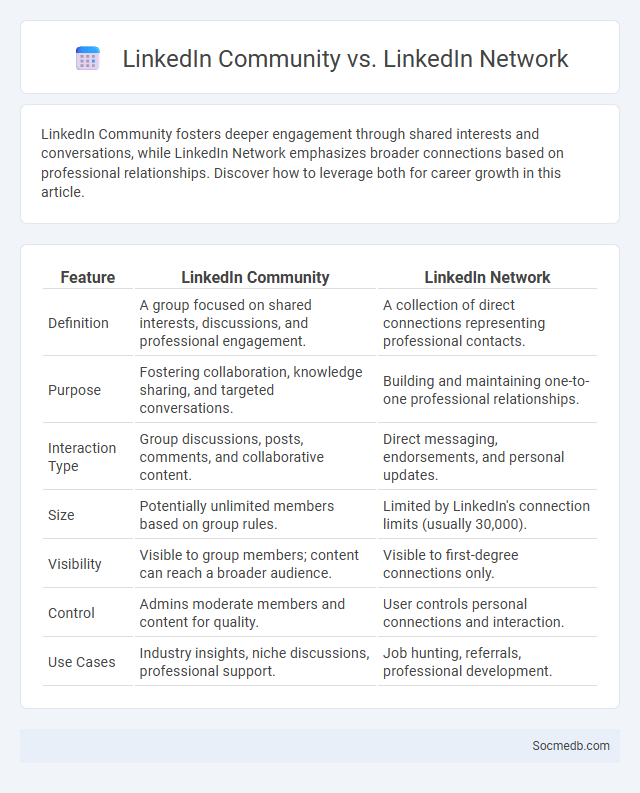
Photo illustration: LinkedIn Community vs LinkedIn Network
LinkedIn Community fosters deeper engagement through shared interests and conversations, while LinkedIn Network emphasizes broader connections based on professional relationships. Discover how to leverage both for career growth in this article.
Table of Comparison
| Feature | LinkedIn Community | LinkedIn Network |
|---|---|---|
| Definition | A group focused on shared interests, discussions, and professional engagement. | A collection of direct connections representing professional contacts. |
| Purpose | Fostering collaboration, knowledge sharing, and targeted conversations. | Building and maintaining one-to-one professional relationships. |
| Interaction Type | Group discussions, posts, comments, and collaborative content. | Direct messaging, endorsements, and personal updates. |
| Size | Potentially unlimited members based on group rules. | Limited by LinkedIn's connection limits (usually 30,000). |
| Visibility | Visible to group members; content can reach a broader audience. | Visible to first-degree connections only. |
| Control | Admins moderate members and content for quality. | User controls personal connections and interaction. |
| Use Cases | Industry insights, niche discussions, professional support. | Job hunting, referrals, professional development. |
Understanding LinkedIn Community: Definition and Purpose
The LinkedIn community is a professional network designed to connect individuals, businesses, and industry experts for career development and knowledge sharing. It facilitates networking, job opportunities, and thought leadership through content, groups, and direct messaging features. This platform enables users to build relationships, enhance professional visibility, and stay updated on industry trends and insights.
What Is a LinkedIn Network? Key Features Explained
A LinkedIn network consists of connections between professionals that enable strategic relationship building for career growth and business opportunities. Key features include the ability to connect with first-, second-, and third-degree contacts, endorse skills, share updates, join industry-specific groups, and access job postings tailored to your professional interests. This network facilitates knowledge exchange, trust-building, and increased visibility among peers, recruiters, and potential clients.
Niche Communities: Meaning and Importance on LinkedIn
Niche communities on LinkedIn are specialized groups centered around specific industries, professions, or interests, fostering meaningful connections among like-minded professionals. Engaging with these communities helps you access targeted insights, share relevant content, and build authority within your field. Leveraging LinkedIn's niche groups can significantly enhance your networking efforts and career growth by connecting you directly with your ideal audience.
Major Differences: LinkedIn Community vs LinkedIn Network
The LinkedIn community consists of groups, followers, and industry-specific conversations fostering engagement and knowledge sharing, while the LinkedIn network primarily comprises direct connections formed through professional relationships and endorsements. Community members often participate in discussions and post content relevant to their fields, creating a dynamic environment for collaboration and influence. In contrast, the network emphasizes one-to-one communication, job opportunities, and personal branding through curated connections and interactions.
Targeted Engagement: The Power of Niche Communities
Targeted engagement in social media leverages the power of niche communities to foster meaningful interactions and build loyal audiences. By focusing on specific interests and demographics, your brand can create content that resonates deeply, driving higher conversion rates and sustained growth. Understanding the unique values and preferences within these communities enables tailored strategies that maximize relevance and impact.
Building Connections: How Networks Fuel Professional Growth
Social media platforms like LinkedIn, Twitter, and Facebook serve as crucial tools for building professional connections and expanding networks within various industries. Engaging with these networks enhances knowledge sharing, mentorship opportunities, and access to job openings, directly contributing to career advancement. Active participation in relevant groups and conversations fosters trust and visibility, accelerating professional growth through collaborative interactions.
Community Management: Best Practices on LinkedIn
Effective community management on LinkedIn involves consistent engagement through personalized responses to comments and messages, fostering authentic connections with industry professionals. Utilizing LinkedIn Analytics to monitor post performance and audience demographics helps tailor content that resonates with the target community, driving higher interaction rates. Implementing LinkedIn Groups and regular LinkedIn Live sessions encourages active discussions, strengthens brand loyalty, and positions your profile as a thought leader within your niche.
The Role of Algorithms in LinkedIn Communities and Networks
Algorithms on LinkedIn play a crucial role in shaping your communities and professional networks by filtering and prioritizing content based on relevance and engagement patterns. These algorithms analyze user interactions, endorsements, and shared interests to surface connections and posts that enhance industry-specific conversations and opportunities. Understanding how LinkedIn's algorithm functions can help you optimize your profile and engagement strategies to build a more targeted and influential network.
Choosing the Right Space: When to Join Niche vs Broad Communities
Choosing the right social media space hinges on your goals and target audience; niche communities offer highly engaged, focused interactions ideal for specialized interests or industries, while broad communities provide greater visibility and diverse networking opportunities. Engagement metrics and content relevance tend to be higher in niche groups, boosting brand loyalty and meaningful connections. Evaluating user demographics and interaction quality helps determine whether a targeted or expansive community best supports your social media strategy.
Future Trends: The Evolution of Online Professional Communities
Online professional communities are rapidly evolving with the integration of AI-driven networking tools and immersive virtual reality environments, enhancing collaboration and personalized interactions. These platforms are increasingly leveraging data analytics to offer tailored career development insights and facilitate real-time skill matching. The future of social media in professional settings emphasizes decentralized networks using blockchain for secure, transparent credential verification and talent discovery.
 socmedb.com
socmedb.com